Organizational Structure at BHP Billiton: Advantages & Disadvantages
VerifiedAdded on 2023/06/11
|12
|2607
|447
Essay
AI Summary
This essay provides an in-depth analysis of BHP Billiton's organizational structure, focusing on its adoption of a matrix project structure. It explores the advantages of this structure, such as enhanced resource sharing, increased communication, and employee skill development, while also addressing its disadvantages, including employee confusion, potential conflicts between managers, and increased operational costs. The essay offers recommendations to mitigate these disadvantages, such as clarifying reporting lines, adopting a strong or weak matrix structure, and emphasizing communication and cooperation. Ultimately, the analysis underscores the importance of a well-defined organizational structure in facilitating a company's growth and competitiveness in the global environment, concluding that BHP Billiton's matrix structure, while beneficial, requires careful management to optimize its effectiveness.
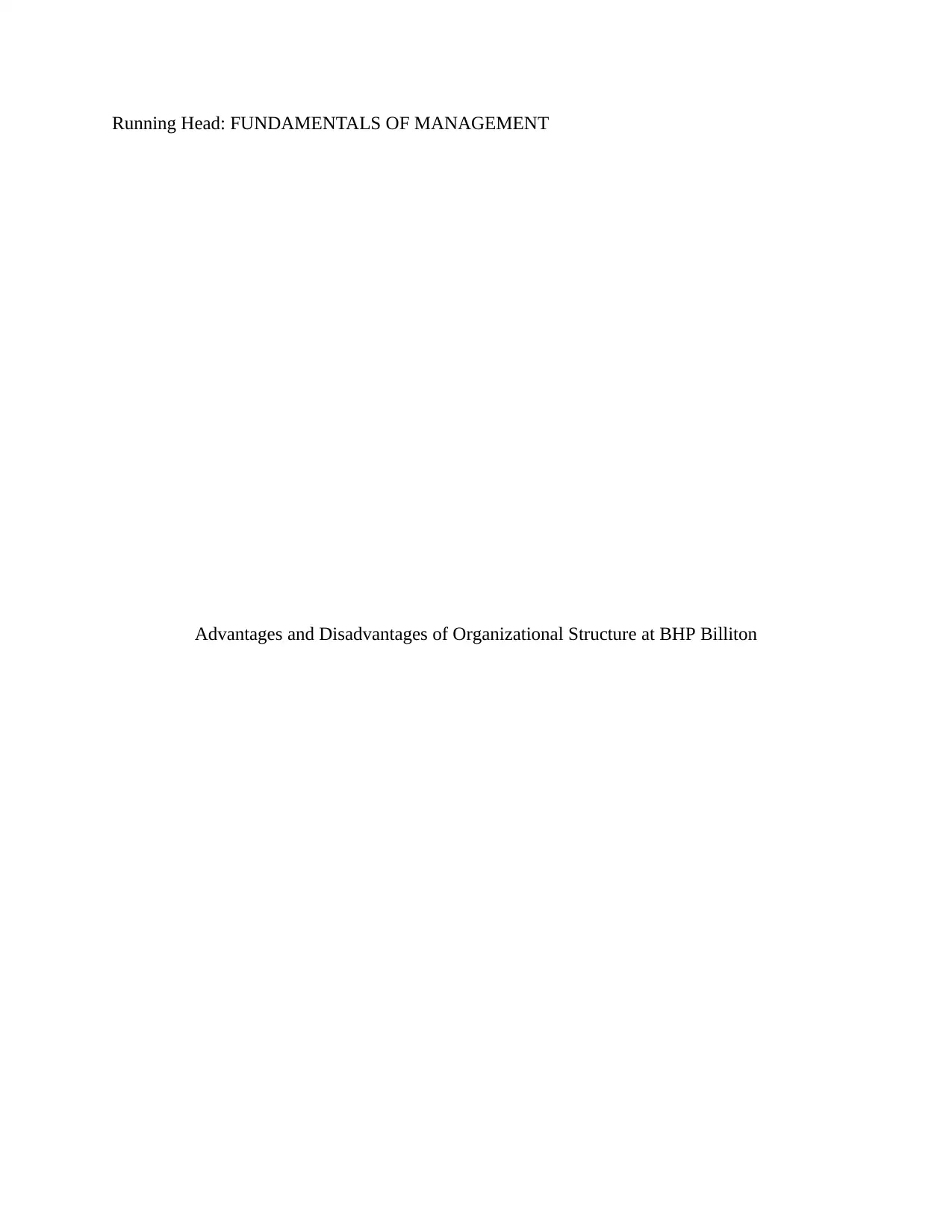
Running Head: FUNDAMENTALS OF MANAGEMENT
Advantages and Disadvantages of Organizational Structure at BHP Billiton
Advantages and Disadvantages of Organizational Structure at BHP Billiton
Paraphrase This Document
Need a fresh take? Get an instant paraphrase of this document with our AI Paraphraser
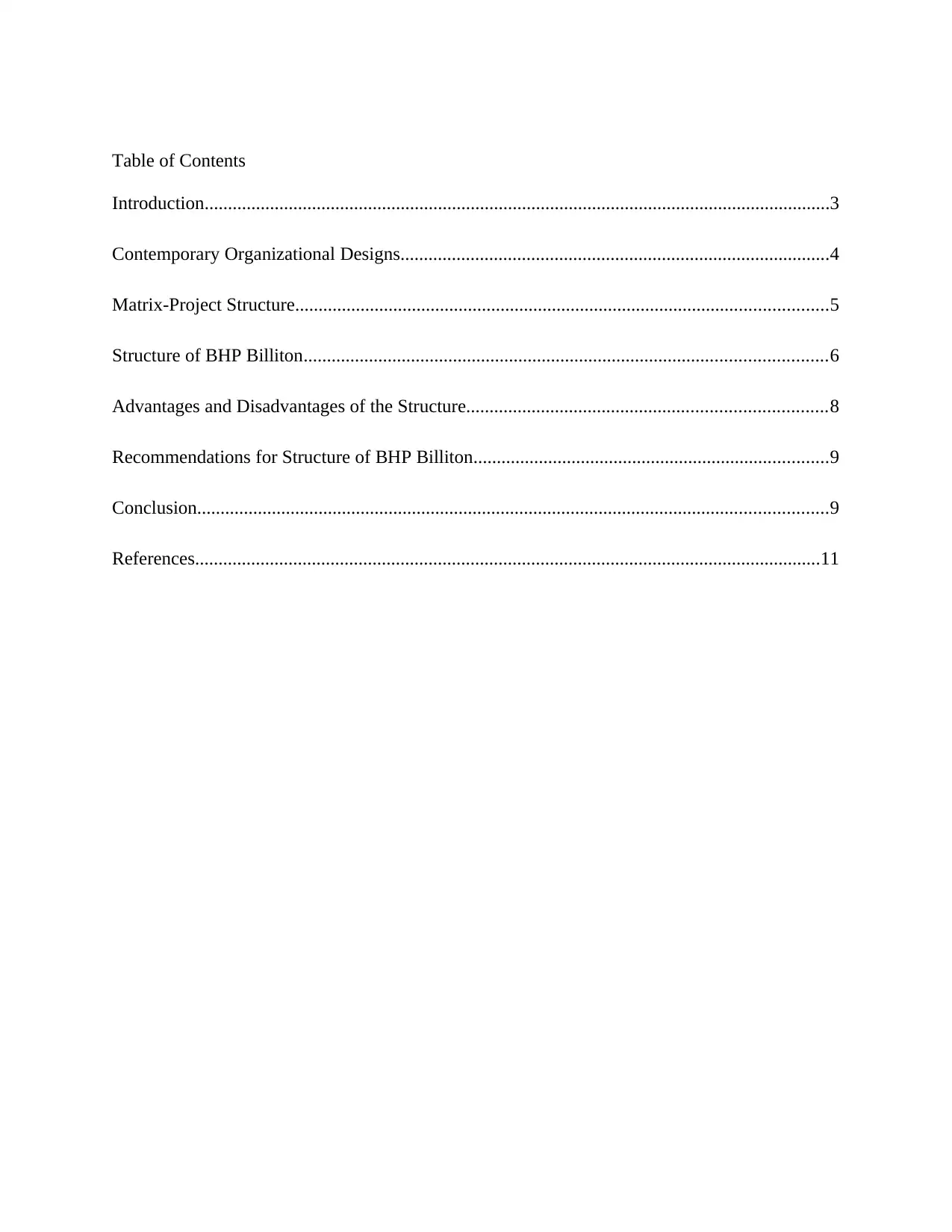
Table of Contents
Introduction......................................................................................................................................3
Contemporary Organizational Designs............................................................................................4
Matrix-Project Structure..................................................................................................................5
Structure of BHP Billiton................................................................................................................6
Advantages and Disadvantages of the Structure.............................................................................8
Recommendations for Structure of BHP Billiton............................................................................9
Conclusion.......................................................................................................................................9
References......................................................................................................................................11
Introduction......................................................................................................................................3
Contemporary Organizational Designs............................................................................................4
Matrix-Project Structure..................................................................................................................5
Structure of BHP Billiton................................................................................................................6
Advantages and Disadvantages of the Structure.............................................................................8
Recommendations for Structure of BHP Billiton............................................................................9
Conclusion.......................................................................................................................................9
References......................................................................................................................................11
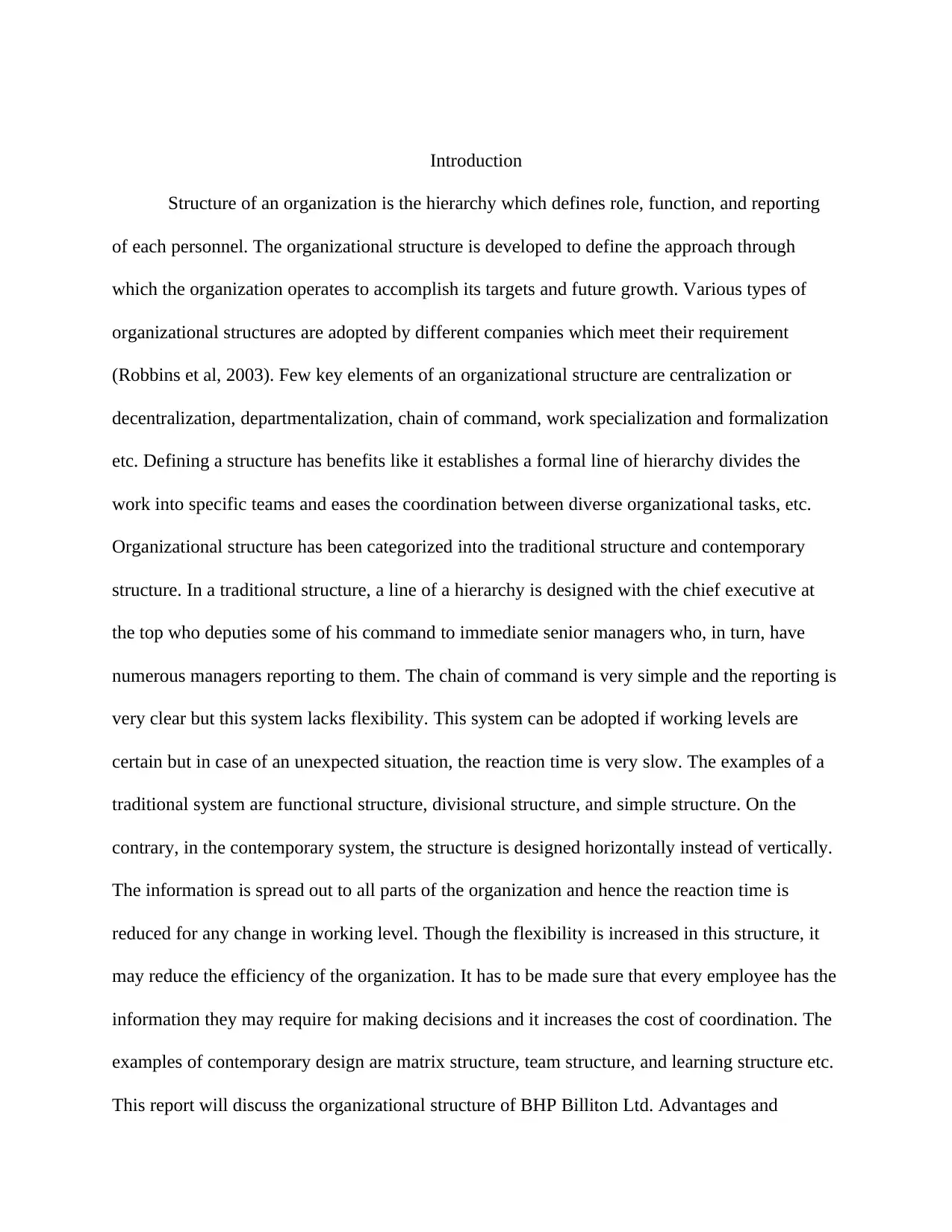
Introduction
Structure of an organization is the hierarchy which defines role, function, and reporting
of each personnel. The organizational structure is developed to define the approach through
which the organization operates to accomplish its targets and future growth. Various types of
organizational structures are adopted by different companies which meet their requirement
(Robbins et al, 2003). Few key elements of an organizational structure are centralization or
decentralization, departmentalization, chain of command, work specialization and formalization
etc. Defining a structure has benefits like it establishes a formal line of hierarchy divides the
work into specific teams and eases the coordination between diverse organizational tasks, etc.
Organizational structure has been categorized into the traditional structure and contemporary
structure. In a traditional structure, a line of a hierarchy is designed with the chief executive at
the top who deputies some of his command to immediate senior managers who, in turn, have
numerous managers reporting to them. The chain of command is very simple and the reporting is
very clear but this system lacks flexibility. This system can be adopted if working levels are
certain but in case of an unexpected situation, the reaction time is very slow. The examples of a
traditional system are functional structure, divisional structure, and simple structure. On the
contrary, in the contemporary system, the structure is designed horizontally instead of vertically.
The information is spread out to all parts of the organization and hence the reaction time is
reduced for any change in working level. Though the flexibility is increased in this structure, it
may reduce the efficiency of the organization. It has to be made sure that every employee has the
information they may require for making decisions and it increases the cost of coordination. The
examples of contemporary design are matrix structure, team structure, and learning structure etc.
This report will discuss the organizational structure of BHP Billiton Ltd. Advantages and
Structure of an organization is the hierarchy which defines role, function, and reporting
of each personnel. The organizational structure is developed to define the approach through
which the organization operates to accomplish its targets and future growth. Various types of
organizational structures are adopted by different companies which meet their requirement
(Robbins et al, 2003). Few key elements of an organizational structure are centralization or
decentralization, departmentalization, chain of command, work specialization and formalization
etc. Defining a structure has benefits like it establishes a formal line of hierarchy divides the
work into specific teams and eases the coordination between diverse organizational tasks, etc.
Organizational structure has been categorized into the traditional structure and contemporary
structure. In a traditional structure, a line of a hierarchy is designed with the chief executive at
the top who deputies some of his command to immediate senior managers who, in turn, have
numerous managers reporting to them. The chain of command is very simple and the reporting is
very clear but this system lacks flexibility. This system can be adopted if working levels are
certain but in case of an unexpected situation, the reaction time is very slow. The examples of a
traditional system are functional structure, divisional structure, and simple structure. On the
contrary, in the contemporary system, the structure is designed horizontally instead of vertically.
The information is spread out to all parts of the organization and hence the reaction time is
reduced for any change in working level. Though the flexibility is increased in this structure, it
may reduce the efficiency of the organization. It has to be made sure that every employee has the
information they may require for making decisions and it increases the cost of coordination. The
examples of contemporary design are matrix structure, team structure, and learning structure etc.
This report will discuss the organizational structure of BHP Billiton Ltd. Advantages and
⊘ This is a preview!⊘
Do you want full access?
Subscribe today to unlock all pages.

Trusted by 1+ million students worldwide
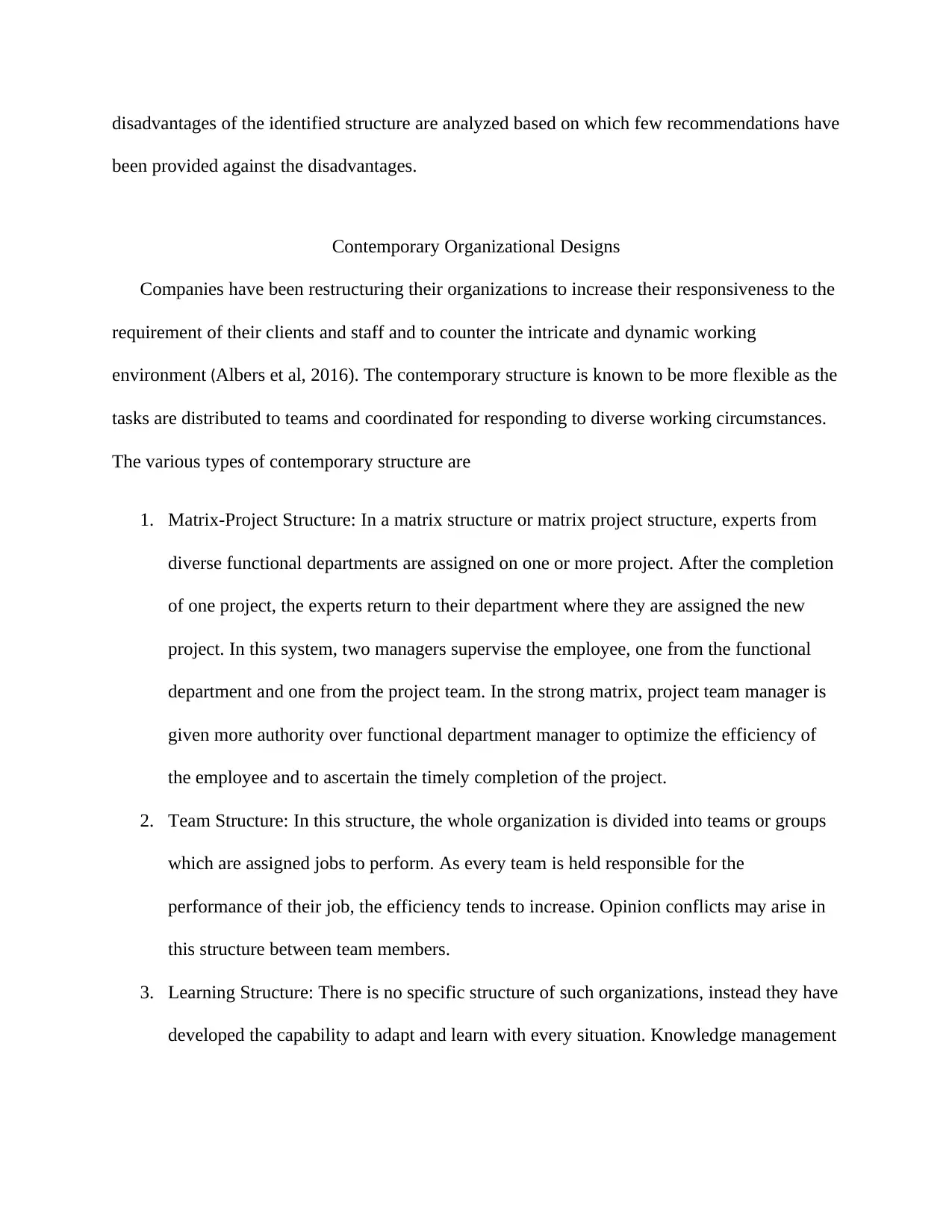
disadvantages of the identified structure are analyzed based on which few recommendations have
been provided against the disadvantages.
Contemporary Organizational Designs
Companies have been restructuring their organizations to increase their responsiveness to the
requirement of their clients and staff and to counter the intricate and dynamic working
environment (Albers et al, 2016). The contemporary structure is known to be more flexible as the
tasks are distributed to teams and coordinated for responding to diverse working circumstances.
The various types of contemporary structure are
1. Matrix-Project Structure: In a matrix structure or matrix project structure, experts from
diverse functional departments are assigned on one or more project. After the completion
of one project, the experts return to their department where they are assigned the new
project. In this system, two managers supervise the employee, one from the functional
department and one from the project team. In the strong matrix, project team manager is
given more authority over functional department manager to optimize the efficiency of
the employee and to ascertain the timely completion of the project.
2. Team Structure: In this structure, the whole organization is divided into teams or groups
which are assigned jobs to perform. As every team is held responsible for the
performance of their job, the efficiency tends to increase. Opinion conflicts may arise in
this structure between team members.
3. Learning Structure: There is no specific structure of such organizations, instead they have
developed the capability to adapt and learn with every situation. Knowledge management
been provided against the disadvantages.
Contemporary Organizational Designs
Companies have been restructuring their organizations to increase their responsiveness to the
requirement of their clients and staff and to counter the intricate and dynamic working
environment (Albers et al, 2016). The contemporary structure is known to be more flexible as the
tasks are distributed to teams and coordinated for responding to diverse working circumstances.
The various types of contemporary structure are
1. Matrix-Project Structure: In a matrix structure or matrix project structure, experts from
diverse functional departments are assigned on one or more project. After the completion
of one project, the experts return to their department where they are assigned the new
project. In this system, two managers supervise the employee, one from the functional
department and one from the project team. In the strong matrix, project team manager is
given more authority over functional department manager to optimize the efficiency of
the employee and to ascertain the timely completion of the project.
2. Team Structure: In this structure, the whole organization is divided into teams or groups
which are assigned jobs to perform. As every team is held responsible for the
performance of their job, the efficiency tends to increase. Opinion conflicts may arise in
this structure between team members.
3. Learning Structure: There is no specific structure of such organizations, instead they have
developed the capability to adapt and learn with every situation. Knowledge management
Paraphrase This Document
Need a fresh take? Get an instant paraphrase of this document with our AI Paraphraser
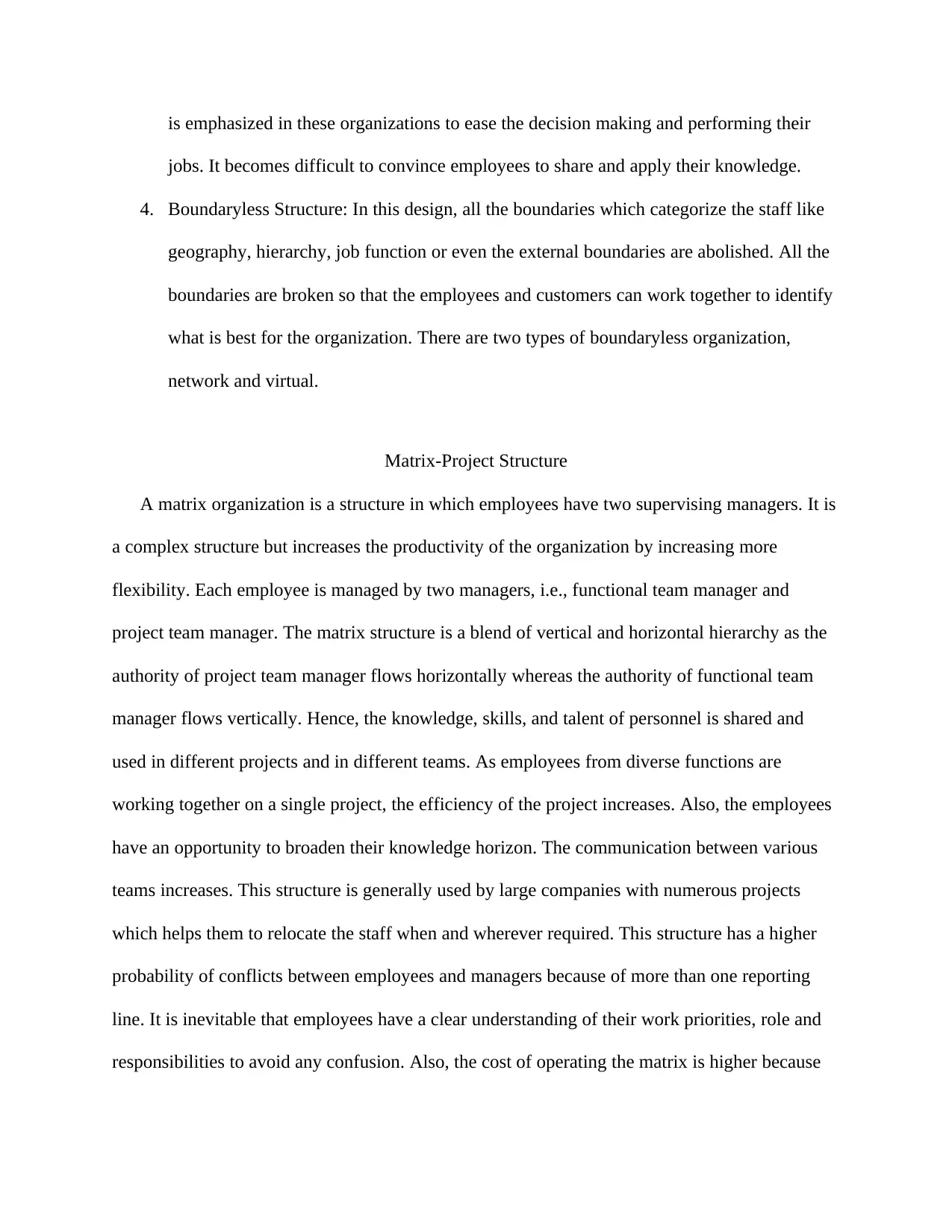
is emphasized in these organizations to ease the decision making and performing their
jobs. It becomes difficult to convince employees to share and apply their knowledge.
4. Boundaryless Structure: In this design, all the boundaries which categorize the staff like
geography, hierarchy, job function or even the external boundaries are abolished. All the
boundaries are broken so that the employees and customers can work together to identify
what is best for the organization. There are two types of boundaryless organization,
network and virtual.
Matrix-Project Structure
A matrix organization is a structure in which employees have two supervising managers. It is
a complex structure but increases the productivity of the organization by increasing more
flexibility. Each employee is managed by two managers, i.e., functional team manager and
project team manager. The matrix structure is a blend of vertical and horizontal hierarchy as the
authority of project team manager flows horizontally whereas the authority of functional team
manager flows vertically. Hence, the knowledge, skills, and talent of personnel is shared and
used in different projects and in different teams. As employees from diverse functions are
working together on a single project, the efficiency of the project increases. Also, the employees
have an opportunity to broaden their knowledge horizon. The communication between various
teams increases. This structure is generally used by large companies with numerous projects
which helps them to relocate the staff when and wherever required. This structure has a higher
probability of conflicts between employees and managers because of more than one reporting
line. It is inevitable that employees have a clear understanding of their work priorities, role and
responsibilities to avoid any confusion. Also, the cost of operating the matrix is higher because
jobs. It becomes difficult to convince employees to share and apply their knowledge.
4. Boundaryless Structure: In this design, all the boundaries which categorize the staff like
geography, hierarchy, job function or even the external boundaries are abolished. All the
boundaries are broken so that the employees and customers can work together to identify
what is best for the organization. There are two types of boundaryless organization,
network and virtual.
Matrix-Project Structure
A matrix organization is a structure in which employees have two supervising managers. It is
a complex structure but increases the productivity of the organization by increasing more
flexibility. Each employee is managed by two managers, i.e., functional team manager and
project team manager. The matrix structure is a blend of vertical and horizontal hierarchy as the
authority of project team manager flows horizontally whereas the authority of functional team
manager flows vertically. Hence, the knowledge, skills, and talent of personnel is shared and
used in different projects and in different teams. As employees from diverse functions are
working together on a single project, the efficiency of the project increases. Also, the employees
have an opportunity to broaden their knowledge horizon. The communication between various
teams increases. This structure is generally used by large companies with numerous projects
which helps them to relocate the staff when and wherever required. This structure has a higher
probability of conflicts between employees and managers because of more than one reporting
line. It is inevitable that employees have a clear understanding of their work priorities, role and
responsibilities to avoid any confusion. Also, the cost of operating the matrix is higher because

of increased cost of coordination and retention of resources. The matrix project structure can be
divided into three main categories
1. Strong Matrix Organization Structure: In this matrix, project team manager has most of
the authority over the employee. Project team manager is responsible for the management
of project administration, project budget, and execution.
2. Balanced Matrix Organization Structure: Authorities are shared between the functional
team manager and project manager under this matrix. Both the managers are responsible
for management of project administration and the budget.
3. Weak Matrix Organization Structure: This structure resembles that of a functional
organizational structure as the functional team manager has most of the authorities over
the employee and project budget. Project team manager acts just as a coordinator in such
structures.
Structure of BHP Billiton
BHP Billiton is a world-renowned company which deals with extracting and processing
of minerals, oil and natural gas with headquarters in Melbourne, Australia. More than 60,000
employees and contractors are working for the company in Australia and America (Billiton,
2017). They are among the world's major producers of commodities like iron ore,
metallurgical coal, and copper, etc. The BHP Billiton Group consists of the BHP Billiton Plc
Group and the BHP Billiton Limited Group as a combined initiative, following the
accomplishment of the Dual Listed Company (DLC) merger in June 2001. BHP Billiton
Limited and BHP Billiton Plc have each retained their distinct corporate identities and upheld
separate stock exchange listings, but they are operated and managed as if they are a single
divided into three main categories
1. Strong Matrix Organization Structure: In this matrix, project team manager has most of
the authority over the employee. Project team manager is responsible for the management
of project administration, project budget, and execution.
2. Balanced Matrix Organization Structure: Authorities are shared between the functional
team manager and project manager under this matrix. Both the managers are responsible
for management of project administration and the budget.
3. Weak Matrix Organization Structure: This structure resembles that of a functional
organizational structure as the functional team manager has most of the authorities over
the employee and project budget. Project team manager acts just as a coordinator in such
structures.
Structure of BHP Billiton
BHP Billiton is a world-renowned company which deals with extracting and processing
of minerals, oil and natural gas with headquarters in Melbourne, Australia. More than 60,000
employees and contractors are working for the company in Australia and America (Billiton,
2017). They are among the world's major producers of commodities like iron ore,
metallurgical coal, and copper, etc. The BHP Billiton Group consists of the BHP Billiton Plc
Group and the BHP Billiton Limited Group as a combined initiative, following the
accomplishment of the Dual Listed Company (DLC) merger in June 2001. BHP Billiton
Limited and BHP Billiton Plc have each retained their distinct corporate identities and upheld
separate stock exchange listings, but they are operated and managed as if they are a single
⊘ This is a preview!⊘
Do you want full access?
Subscribe today to unlock all pages.

Trusted by 1+ million students worldwide
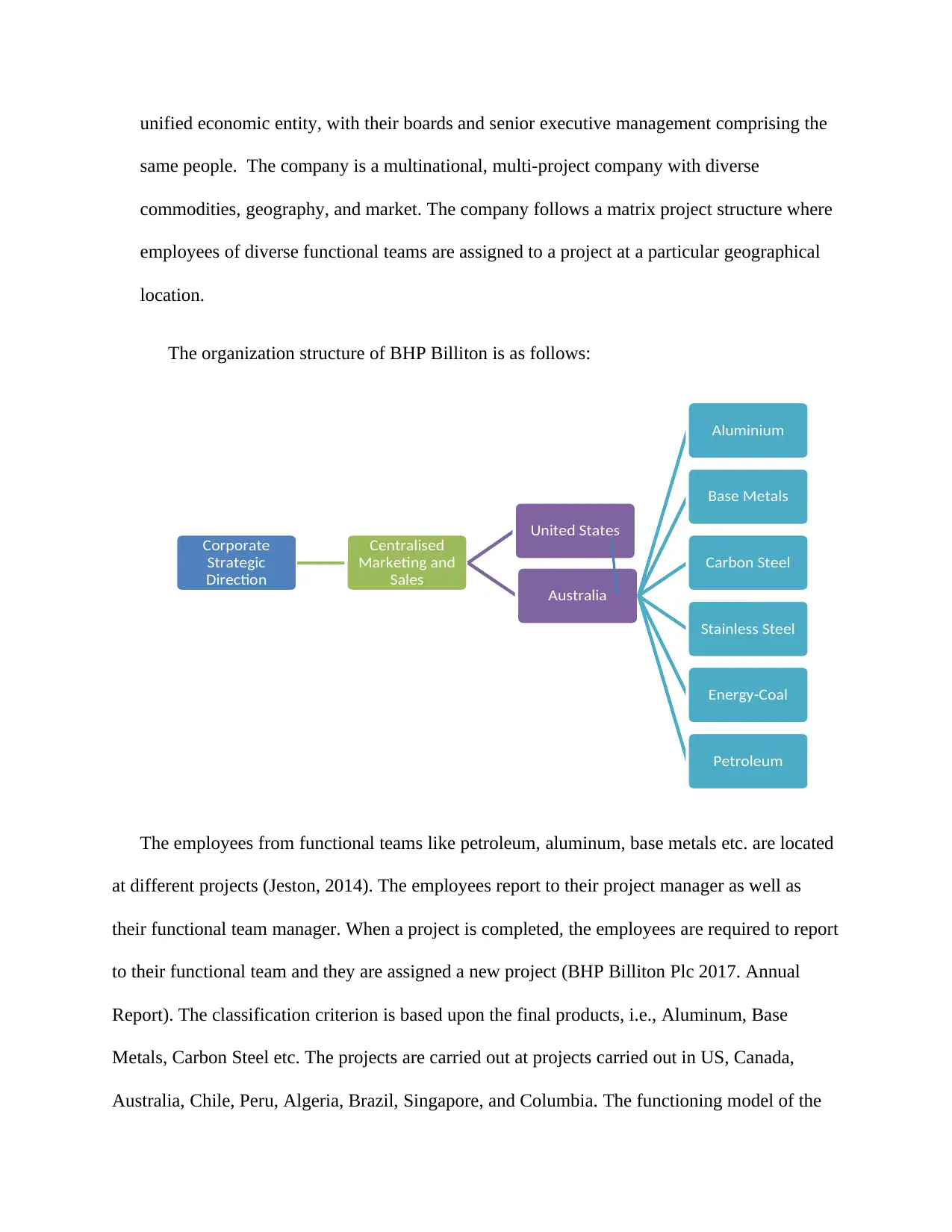
unified economic entity, with their boards and senior executive management comprising the
same people. The company is a multinational, multi-project company with diverse
commodities, geography, and market. The company follows a matrix project structure where
employees of diverse functional teams are assigned to a project at a particular geographical
location.
The organization structure of BHP Billiton is as follows:
The employees from functional teams like petroleum, aluminum, base metals etc. are located
at different projects (Jeston, 2014). The employees report to their project manager as well as
their functional team manager. When a project is completed, the employees are required to report
to their functional team and they are assigned a new project (BHP Billiton Plc 2017. Annual
Report). The classification criterion is based upon the final products, i.e., Aluminum, Base
Metals, Carbon Steel etc. The projects are carried out at projects carried out in US, Canada,
Australia, Chile, Peru, Algeria, Brazil, Singapore, and Columbia. The functioning model of the
Corporate
Strategic
Direction
Centralised
Marketing and
Sales
United States
Australia
Aluminium
Base Metals
Carbon Steel
Stainless Steel
Energy-Coal
Petroleum
same people. The company is a multinational, multi-project company with diverse
commodities, geography, and market. The company follows a matrix project structure where
employees of diverse functional teams are assigned to a project at a particular geographical
location.
The organization structure of BHP Billiton is as follows:
The employees from functional teams like petroleum, aluminum, base metals etc. are located
at different projects (Jeston, 2014). The employees report to their project manager as well as
their functional team manager. When a project is completed, the employees are required to report
to their functional team and they are assigned a new project (BHP Billiton Plc 2017. Annual
Report). The classification criterion is based upon the final products, i.e., Aluminum, Base
Metals, Carbon Steel etc. The projects are carried out at projects carried out in US, Canada,
Australia, Chile, Peru, Algeria, Brazil, Singapore, and Columbia. The functioning model of the
Corporate
Strategic
Direction
Centralised
Marketing and
Sales
United States
Australia
Aluminium
Base Metals
Carbon Steel
Stainless Steel
Energy-Coal
Petroleum
Paraphrase This Document
Need a fresh take? Get an instant paraphrase of this document with our AI Paraphraser
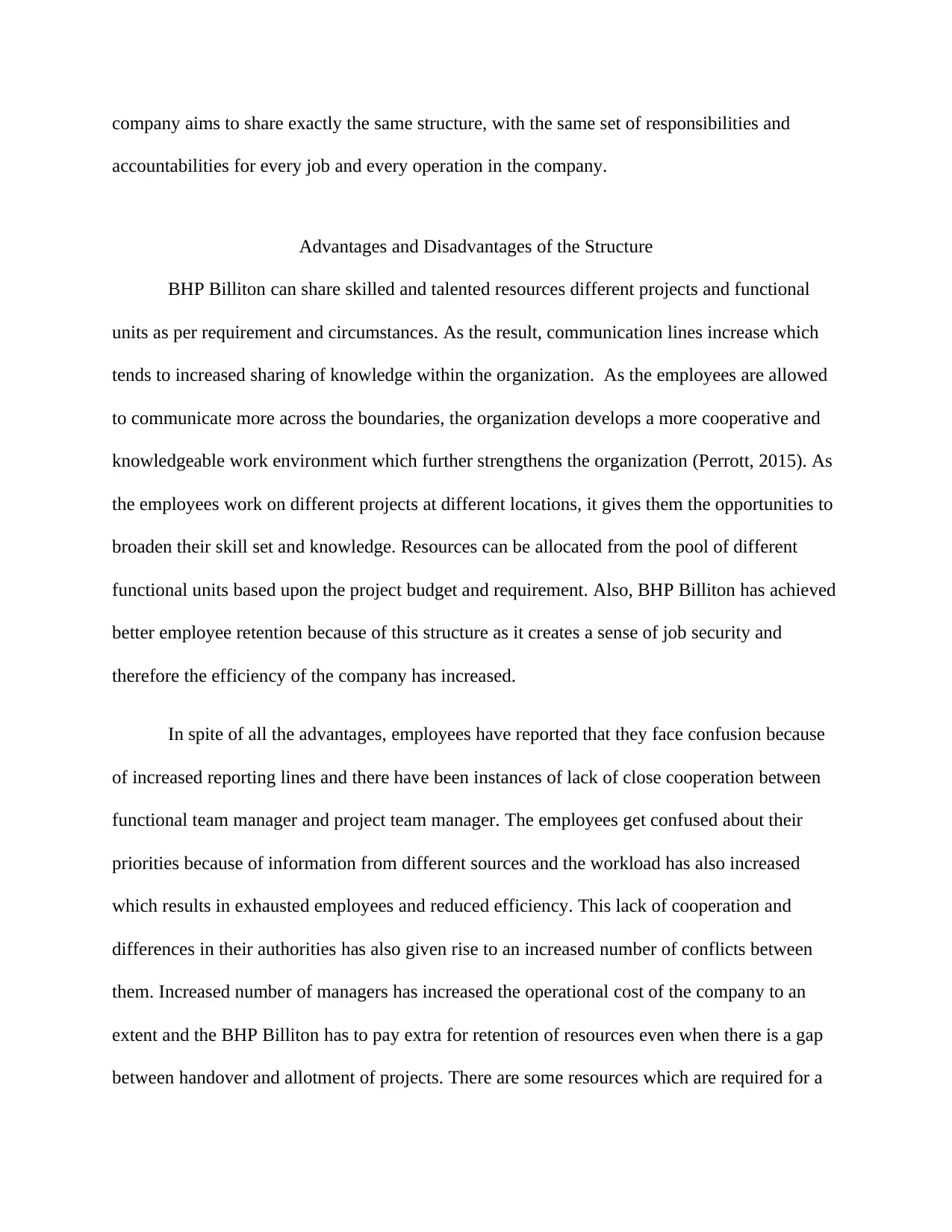
company aims to share exactly the same structure, with the same set of responsibilities and
accountabilities for every job and every operation in the company.
Advantages and Disadvantages of the Structure
BHP Billiton can share skilled and talented resources different projects and functional
units as per requirement and circumstances. As the result, communication lines increase which
tends to increased sharing of knowledge within the organization. As the employees are allowed
to communicate more across the boundaries, the organization develops a more cooperative and
knowledgeable work environment which further strengthens the organization (Perrott, 2015). As
the employees work on different projects at different locations, it gives them the opportunities to
broaden their skill set and knowledge. Resources can be allocated from the pool of different
functional units based upon the project budget and requirement. Also, BHP Billiton has achieved
better employee retention because of this structure as it creates a sense of job security and
therefore the efficiency of the company has increased.
In spite of all the advantages, employees have reported that they face confusion because
of increased reporting lines and there have been instances of lack of close cooperation between
functional team manager and project team manager. The employees get confused about their
priorities because of information from different sources and the workload has also increased
which results in exhausted employees and reduced efficiency. This lack of cooperation and
differences in their authorities has also given rise to an increased number of conflicts between
them. Increased number of managers has increased the operational cost of the company to an
extent and the BHP Billiton has to pay extra for retention of resources even when there is a gap
between handover and allotment of projects. There are some resources which are required for a
accountabilities for every job and every operation in the company.
Advantages and Disadvantages of the Structure
BHP Billiton can share skilled and talented resources different projects and functional
units as per requirement and circumstances. As the result, communication lines increase which
tends to increased sharing of knowledge within the organization. As the employees are allowed
to communicate more across the boundaries, the organization develops a more cooperative and
knowledgeable work environment which further strengthens the organization (Perrott, 2015). As
the employees work on different projects at different locations, it gives them the opportunities to
broaden their skill set and knowledge. Resources can be allocated from the pool of different
functional units based upon the project budget and requirement. Also, BHP Billiton has achieved
better employee retention because of this structure as it creates a sense of job security and
therefore the efficiency of the company has increased.
In spite of all the advantages, employees have reported that they face confusion because
of increased reporting lines and there have been instances of lack of close cooperation between
functional team manager and project team manager. The employees get confused about their
priorities because of information from different sources and the workload has also increased
which results in exhausted employees and reduced efficiency. This lack of cooperation and
differences in their authorities has also given rise to an increased number of conflicts between
them. Increased number of managers has increased the operational cost of the company to an
extent and the BHP Billiton has to pay extra for retention of resources even when there is a gap
between handover and allotment of projects. There are some resources which are required for a
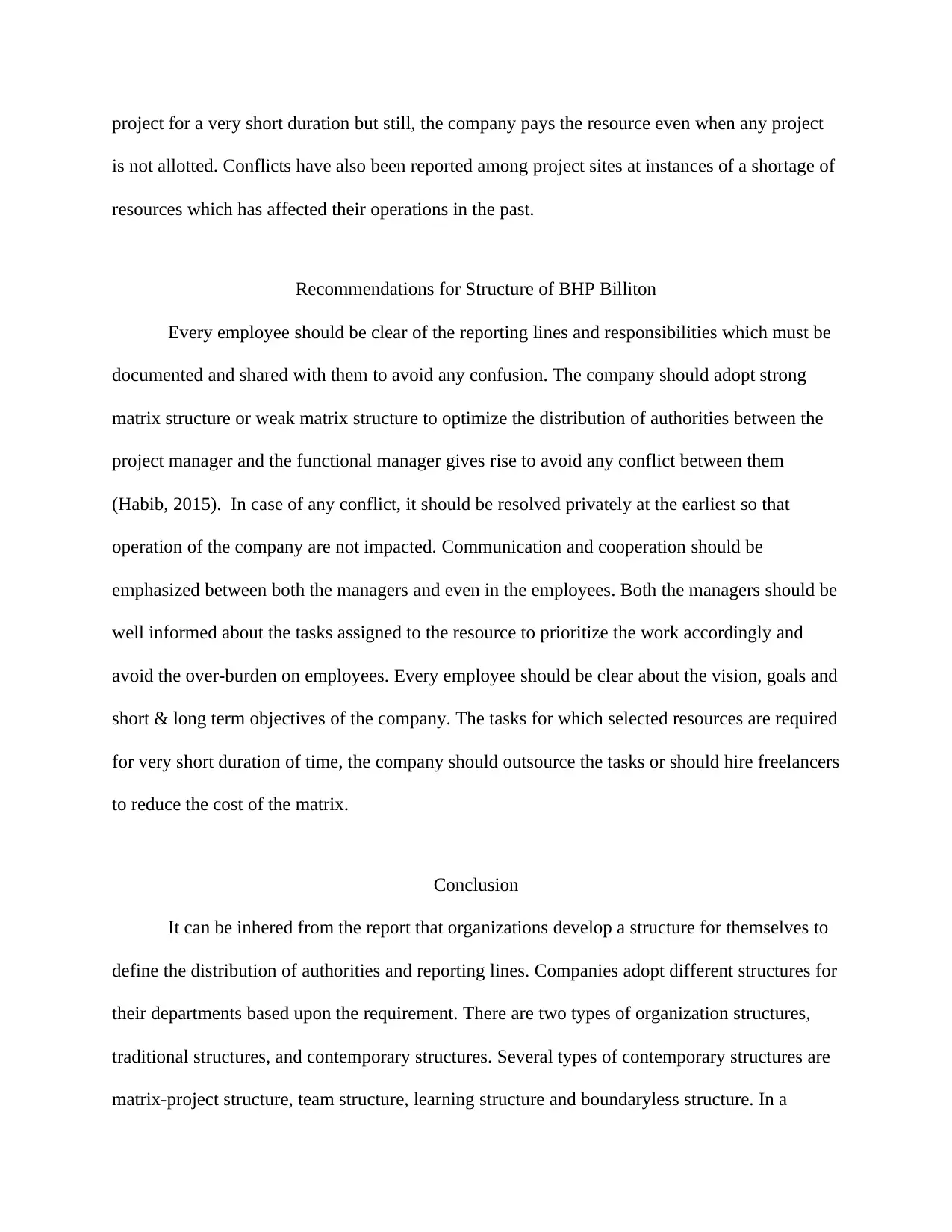
project for a very short duration but still, the company pays the resource even when any project
is not allotted. Conflicts have also been reported among project sites at instances of a shortage of
resources which has affected their operations in the past.
Recommendations for Structure of BHP Billiton
Every employee should be clear of the reporting lines and responsibilities which must be
documented and shared with them to avoid any confusion. The company should adopt strong
matrix structure or weak matrix structure to optimize the distribution of authorities between the
project manager and the functional manager gives rise to avoid any conflict between them
(Habib, 2015). In case of any conflict, it should be resolved privately at the earliest so that
operation of the company are not impacted. Communication and cooperation should be
emphasized between both the managers and even in the employees. Both the managers should be
well informed about the tasks assigned to the resource to prioritize the work accordingly and
avoid the over-burden on employees. Every employee should be clear about the vision, goals and
short & long term objectives of the company. The tasks for which selected resources are required
for very short duration of time, the company should outsource the tasks or should hire freelancers
to reduce the cost of the matrix.
Conclusion
It can be inhered from the report that organizations develop a structure for themselves to
define the distribution of authorities and reporting lines. Companies adopt different structures for
their departments based upon the requirement. There are two types of organization structures,
traditional structures, and contemporary structures. Several types of contemporary structures are
matrix-project structure, team structure, learning structure and boundaryless structure. In a
is not allotted. Conflicts have also been reported among project sites at instances of a shortage of
resources which has affected their operations in the past.
Recommendations for Structure of BHP Billiton
Every employee should be clear of the reporting lines and responsibilities which must be
documented and shared with them to avoid any confusion. The company should adopt strong
matrix structure or weak matrix structure to optimize the distribution of authorities between the
project manager and the functional manager gives rise to avoid any conflict between them
(Habib, 2015). In case of any conflict, it should be resolved privately at the earliest so that
operation of the company are not impacted. Communication and cooperation should be
emphasized between both the managers and even in the employees. Both the managers should be
well informed about the tasks assigned to the resource to prioritize the work accordingly and
avoid the over-burden on employees. Every employee should be clear about the vision, goals and
short & long term objectives of the company. The tasks for which selected resources are required
for very short duration of time, the company should outsource the tasks or should hire freelancers
to reduce the cost of the matrix.
Conclusion
It can be inhered from the report that organizations develop a structure for themselves to
define the distribution of authorities and reporting lines. Companies adopt different structures for
their departments based upon the requirement. There are two types of organization structures,
traditional structures, and contemporary structures. Several types of contemporary structures are
matrix-project structure, team structure, learning structure and boundaryless structure. In a
⊘ This is a preview!⊘
Do you want full access?
Subscribe today to unlock all pages.

Trusted by 1+ million students worldwide
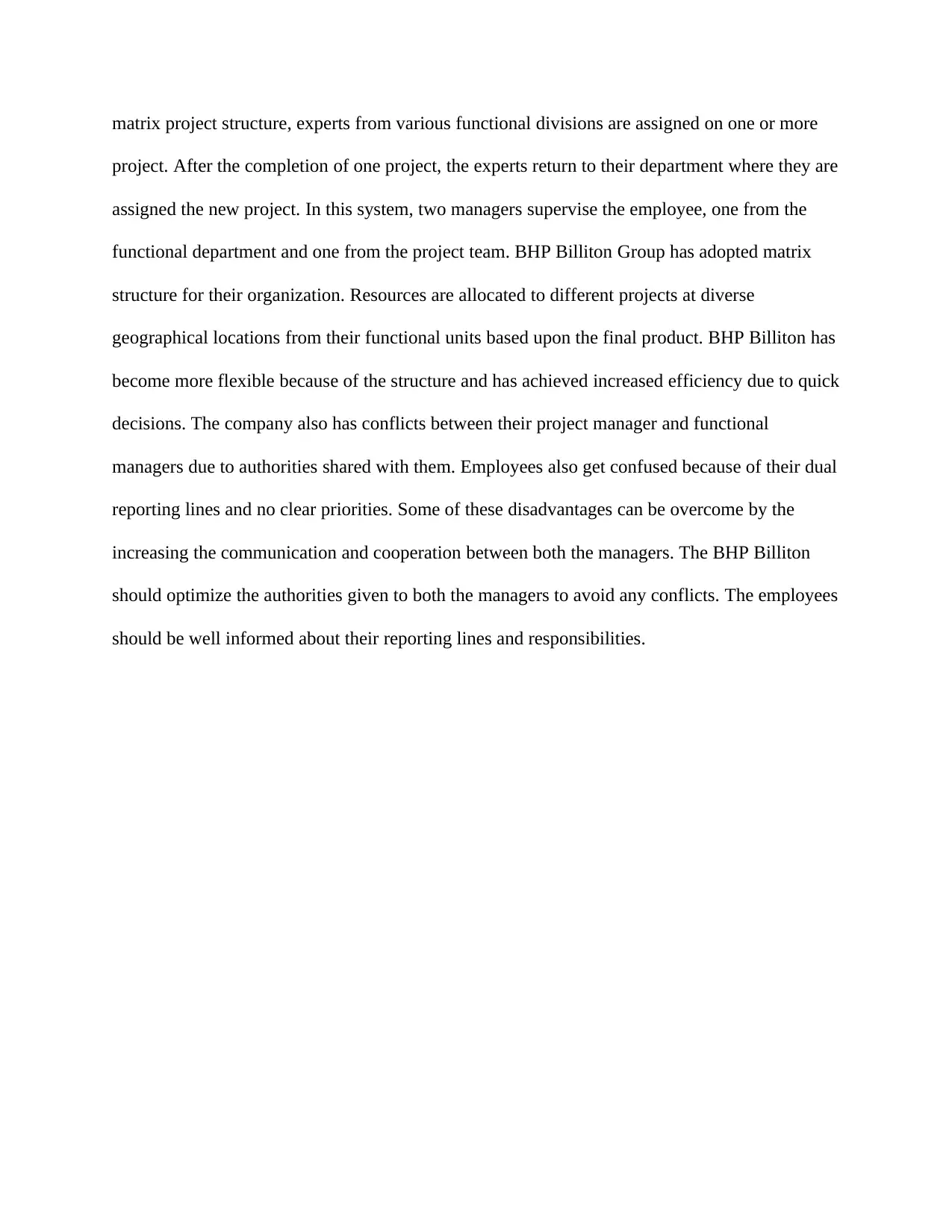
matrix project structure, experts from various functional divisions are assigned on one or more
project. After the completion of one project, the experts return to their department where they are
assigned the new project. In this system, two managers supervise the employee, one from the
functional department and one from the project team. BHP Billiton Group has adopted matrix
structure for their organization. Resources are allocated to different projects at diverse
geographical locations from their functional units based upon the final product. BHP Billiton has
become more flexible because of the structure and has achieved increased efficiency due to quick
decisions. The company also has conflicts between their project manager and functional
managers due to authorities shared with them. Employees also get confused because of their dual
reporting lines and no clear priorities. Some of these disadvantages can be overcome by the
increasing the communication and cooperation between both the managers. The BHP Billiton
should optimize the authorities given to both the managers to avoid any conflicts. The employees
should be well informed about their reporting lines and responsibilities.
project. After the completion of one project, the experts return to their department where they are
assigned the new project. In this system, two managers supervise the employee, one from the
functional department and one from the project team. BHP Billiton Group has adopted matrix
structure for their organization. Resources are allocated to different projects at diverse
geographical locations from their functional units based upon the final product. BHP Billiton has
become more flexible because of the structure and has achieved increased efficiency due to quick
decisions. The company also has conflicts between their project manager and functional
managers due to authorities shared with them. Employees also get confused because of their dual
reporting lines and no clear priorities. Some of these disadvantages can be overcome by the
increasing the communication and cooperation between both the managers. The BHP Billiton
should optimize the authorities given to both the managers to avoid any conflicts. The employees
should be well informed about their reporting lines and responsibilities.
Paraphrase This Document
Need a fresh take? Get an instant paraphrase of this document with our AI Paraphraser
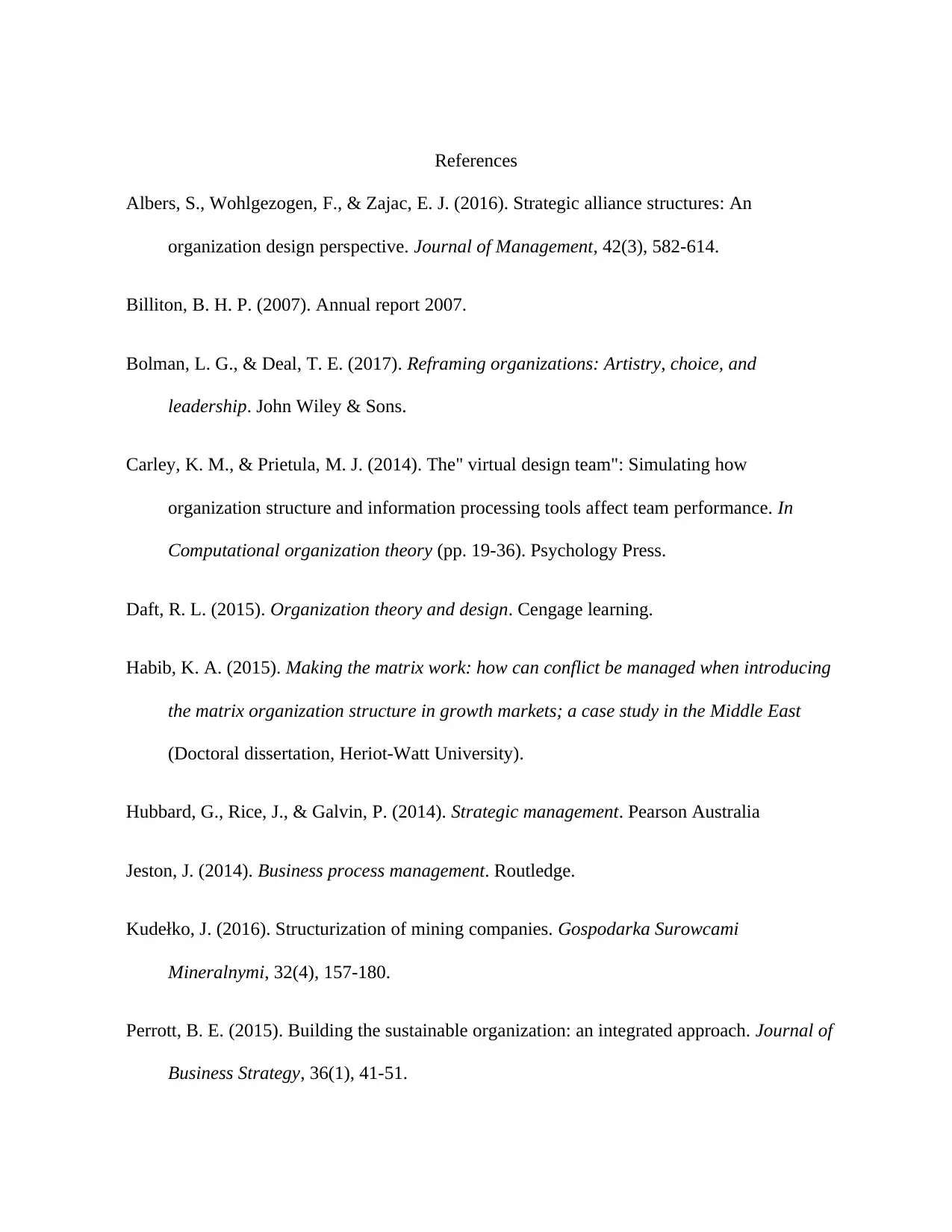
References
Albers, S., Wohlgezogen, F., & Zajac, E. J. (2016). Strategic alliance structures: An
organization design perspective. Journal of Management, 42(3), 582-614.
Billiton, B. H. P. (2007). Annual report 2007.
Bolman, L. G., & Deal, T. E. (2017). Reframing organizations: Artistry, choice, and
leadership. John Wiley & Sons.
Carley, K. M., & Prietula, M. J. (2014). The" virtual design team": Simulating how
organization structure and information processing tools affect team performance. In
Computational organization theory (pp. 19-36). Psychology Press.
Daft, R. L. (2015). Organization theory and design. Cengage learning.
Habib, K. A. (2015). Making the matrix work: how can conflict be managed when introducing
the matrix organization structure in growth markets; a case study in the Middle East
(Doctoral dissertation, Heriot-Watt University).
Hubbard, G., Rice, J., & Galvin, P. (2014). Strategic management. Pearson Australia
Jeston, J. (2014). Business process management. Routledge.
Kudełko, J. (2016). Structurization of mining companies. Gospodarka Surowcami
Mineralnymi, 32(4), 157-180.
Perrott, B. E. (2015). Building the sustainable organization: an integrated approach. Journal of
Business Strategy, 36(1), 41-51.
Albers, S., Wohlgezogen, F., & Zajac, E. J. (2016). Strategic alliance structures: An
organization design perspective. Journal of Management, 42(3), 582-614.
Billiton, B. H. P. (2007). Annual report 2007.
Bolman, L. G., & Deal, T. E. (2017). Reframing organizations: Artistry, choice, and
leadership. John Wiley & Sons.
Carley, K. M., & Prietula, M. J. (2014). The" virtual design team": Simulating how
organization structure and information processing tools affect team performance. In
Computational organization theory (pp. 19-36). Psychology Press.
Daft, R. L. (2015). Organization theory and design. Cengage learning.
Habib, K. A. (2015). Making the matrix work: how can conflict be managed when introducing
the matrix organization structure in growth markets; a case study in the Middle East
(Doctoral dissertation, Heriot-Watt University).
Hubbard, G., Rice, J., & Galvin, P. (2014). Strategic management. Pearson Australia
Jeston, J. (2014). Business process management. Routledge.
Kudełko, J. (2016). Structurization of mining companies. Gospodarka Surowcami
Mineralnymi, 32(4), 157-180.
Perrott, B. E. (2015). Building the sustainable organization: an integrated approach. Journal of
Business Strategy, 36(1), 41-51.

Robbins, Stephen P., and Mary Coulter. Management. Pearson Education, 2010.
⊘ This is a preview!⊘
Do you want full access?
Subscribe today to unlock all pages.

Trusted by 1+ million students worldwide
1 out of 12
Related Documents
Your All-in-One AI-Powered Toolkit for Academic Success.
+13062052269
info@desklib.com
Available 24*7 on WhatsApp / Email
![[object Object]](/_next/static/media/star-bottom.7253800d.svg)
Unlock your academic potential
Copyright © 2020–2025 A2Z Services. All Rights Reserved. Developed and managed by ZUCOL.





